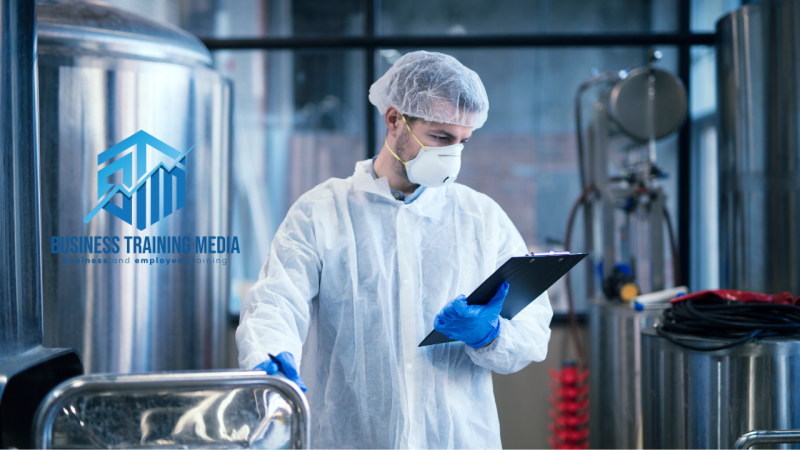
Food Processing and Handling Safety Guide
By Business Training Media
Food processing and handling safety are essential aspects of the food industry. It involves a set of practices that ensure the safety and quality of food products from the time they are harvested to the time they reach consumers. In this article, we will discuss the importance of food processing and handling safety, the key guidelines that food processors and handlers should follow, and the benefits of implementing these guidelines.
Importance of Food Processing and Handling Safety
Food processing and handling safety is crucial to preventing the spread of foodborne illnesses, which can cause severe health problems and even death. According to the Centers for Disease Control and Prevention (CDC), foodborne illnesses affect one in six Americans every year, leading to approximately 128,000 hospitalizations and 3,000 deaths. Bacteria, viruses, parasites, and other harmful microorganisms that can contaminate food during processing and handling are the cause of these illnesses.
In addition to the health risks, foodborne illnesses can also have a significant economic impact. Outbreaks of foodborne illnesses can lead to the recall of millions of pounds of food products, resulting in losses for food processors and retailers. Furthermore, consumers may lose confidence in the safety of the food supply, leading to a decrease in demand for food products and a negative impact on the food industry.
Key Guidelines for Food Processing and Handling Safety
To ensure the safety and quality of food products, food processors and handlers must follow a set of guidelines that cover the entire process, from farm to table. Some of the key guidelines include:
- Good Agricultural Practices (GAPs): GAPs are a set of guidelines that cover the production of crops and livestock. They include practices such as using clean water for irrigation and animal drinking, preventing contamination by wild animals, and avoiding the use of hazardous chemicals.
- Good Manufacturing Practices (GMPs): GMPs are a set of guidelines that cover the processing of food products. They include practices such as maintaining clean and sanitary facilities, training employees on food safety, and using proper equipment for processing and packaging.
- Hazard Analysis and Critical Control Points (HACCP): HACCP is a systematic approach to food safety that identifies and controls potential hazards in the production process. It involves seven principles, including conducting a hazard analysis, identifying critical control points, establishing critical limits, and monitoring and verifying the process.
- Sanitation Standard Operating Procedures (SSOPs): SSOPs are a set of guidelines that cover the cleaning and sanitation of facilities and equipment. They include practices such as cleaning and sanitizing surfaces and equipment, storing cleaning chemicals safely, and maintaining records of cleaning activities.
- Personal Hygiene: Personal hygiene is an essential aspect of food processing and handling safety. It includes practices such as washing hands regularly, wearing clean clothing and hairnets, and avoiding smoking or chewing gum in food processing areas.
Benefits of Implementing Food Processing and Handling Safety Guidelines
Implementing food processing and handling safety guidelines has several benefits for food processors and handlers, as well as consumers. Some of the key benefits include:
- Improved Food Safety: Implementing food processing and handling safety guidelines reduces the risk of contamination by harmful microorganisms, ensuring the safety of food products.
- Increased Consumer Confidence: Consumers are more likely to trust food products that are produced and handled using safe practices, leading to increased demand for these products.
- Reduced Risk of Recalls: Implementing food processing and handling safety guidelines reduces the risk of outbreaks of foodborne illnesses, leading to fewer recalls and losses for food processors and retailers.
- Compliance with Regulations: Food processors and handlers who implement food processing and handling safety guidelines are more likely to comply with regulatory requirements, avoiding fines and legal penalties.
Finally, food processing and handling safety is a critical aspect of the food industry, as it ensures the safety and quality of food products from farm to table. By following key guidelines such as Good Agricultural Practices (GAPs), Good Manufacturing Practices (GMPs), Hazard Analysis and Critical Control Points (HACCP), Sanitation Standard Operating Procedures (SSOPs), and personal hygiene practices, food processors and handlers can reduce the risk of foodborne illnesses and increase consumer confidence in the safety of food products.
Implementing food processing and handling safety guidelines has several benefits, including improved food safety, increased consumer confidence, a reduced risk of recalls, and compliance with regulations. These benefits can have a positive impact on the food industry as a whole, leading to increased demand for safe and high-quality food products and reduced economic losses due to foodborne illnesses.
Food processors and handlers play a critical role in ensuring the safety and quality of food products. By following food processing and handling safety guidelines, they can reduce the risk of foodborne illnesses and promote consumer confidence in the safety of the food supply.
Copyright 2023: Business Training Media
About the author:
Business Training Media is a global provider of workplace training videos and online courses for employees, managers, supervisors, and students. The company has provided training solutions to over 22,000 organizations worldwide, from start-ups to high-profile companies like American Express, IBM, 3M, FedEx, American Honda, Cisco, Verizon, Microsoft, AT&T, Bank of America, Google, and thousands of others.

Cleaning and Sanitizing in Food Processing and Handling Environments Part I: Cleaning
Employees who work with food need to be committed to creating products that are safe to eat. So it's important that they follow good cleaning procedures in their facility.




